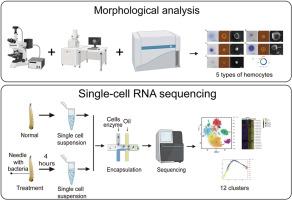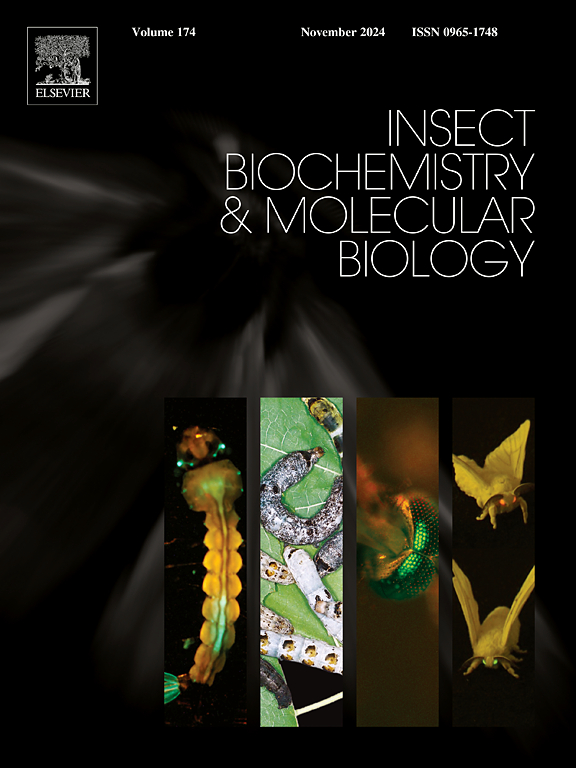基于形态学观察和单细胞RNA测序的家蝇血细胞类型鉴定及其免疫功能表征。
IF 3.7
2区 农林科学
Q2 BIOCHEMISTRY & MOLECULAR BIOLOGY
引用次数: 0
摘要
血细胞是昆虫通过细胞和体液免疫机制防御病原体的关键因素。然而,血细胞类型和功能在不同昆虫类群中表现出差异,导致昆虫血细胞缺乏标准化的分类系统。为了深入了解家蝇的免疫机制,我们采用形态学观察和单细胞RNA测序技术(scRNA-seq)相结合的方法对家蝇幼虫血细胞进行了分类表征,并分析了其免疫功能。结果表明,家蝇幼虫有5种不同类型的血细胞,分别是粒细胞(GR)、球型粒细胞(SP)、浆细胞(PL)、造血原细胞(PR)和嗜酸细胞(OE)。根据显微镜观察、流式细胞术分析和基因表达谱,我们假设家蝇血细胞的免疫功能如下:GRs负责吞噬,SPs高表达凝集素,PLs高表达抗菌肽(AMPs)并参与结节形成,pr作为祖细胞并保留干细胞的分化潜力,OEs主要通过表达酚氧化酶(PO)参与黑色素化反应。根据scRNA-seq数据,确定了每种类型血细胞的标记基因。本研究揭示了家蝇血细胞在形态、基因表达特征和功能等方面的异质性,为深入了解家蝇免疫机制奠定了基础。本文章由计算机程序翻译,如有差异,请以英文原文为准。

Identification of hemocyte types and characterization of their immune function in the house fly based on morphological observation and single-cell RNA sequencing
Hemocytes represent a pivotal element of insect defense against pathogens through the mechanisms of cellular and humoral immunity. However, hemocyte types and functions exhibit variation across different insect taxa, leading to the lack of a standardized classification system for insect hemocytes. To gain insight into the immune mechanisms of the house fly Musca domestica, we used a combination of morphological observations and single-cell RNA sequencing techniques (scRNA-seq) to taxonomically characterize house fly larval hemocytes and analyze their immune function. As a result, five different types of hemocytes were identified from house fly larvae, granulocytes (GR), spherulocytes (SP), plasmatocytes (PL), prohemocytes (PR), and oenocytoids (OE). On the basis of microscopic observations, flow cytometry analysis and gene expression profiles, the immune functions of house fly hemocytes were hypothesized to be as follows: the GRs are responsible for phagocytosis, the SPs are highly expressive of lectins, and the PLs are highly expressive of antimicrobial peptides (AMPs) and are involved in nodule formation, the PRs act as progenitor cells and retain the differentiation potential of stem cells, and the OEs are involved in melanization reactions mainly through the expression of phenoloxidase (PO). Based on the scRNA-seq data, the marker genes for each type of hemocyte were identified. The present study unveils the heterogeneity of house fly hemocytes in terms of morphology, gene expression characteristics, and function, thereby establishing the foundation for an in-depth understanding of the immune mechanisms in house fly.
求助全文
通过发布文献求助,成功后即可免费获取论文全文。
去求助
来源期刊
CiteScore
7.40
自引率
5.30%
发文量
105
审稿时长
40 days
期刊介绍:
This international journal publishes original contributions and mini-reviews in the fields of insect biochemistry and insect molecular biology. Main areas of interest are neurochemistry, hormone and pheromone biochemistry, enzymes and metabolism, hormone action and gene regulation, gene characterization and structure, pharmacology, immunology and cell and tissue culture. Papers on the biochemistry and molecular biology of other groups of arthropods are published if of general interest to the readership. Technique papers will be considered for publication if they significantly advance the field of insect biochemistry and molecular biology in the opinion of the Editors and Editorial Board.

 求助内容:
求助内容: 应助结果提醒方式:
应助结果提醒方式:


